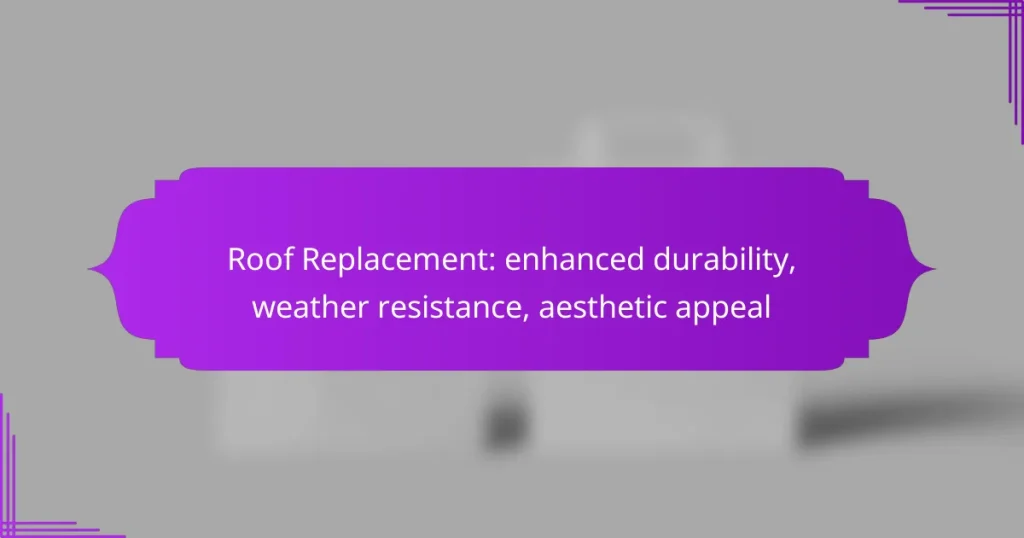Roof replacement in the UK provides significant advantages, including enhanced durability, improved weather resistance, and increased aesthetic appeal. These upgrades not only safeguard your home against the elements but also elevate its market value, making it a worthwhile investment for homeowners.
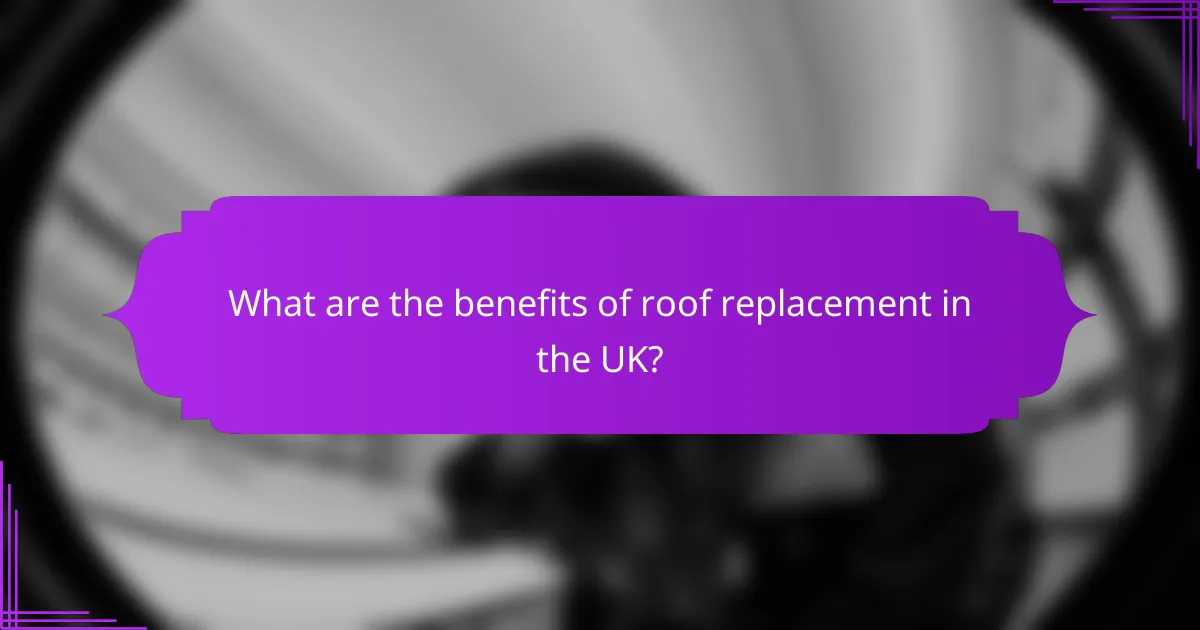
What are the benefits of roof replacement in the UK?
Roof replacement in the UK offers several advantages, including enhanced durability, improved weather resistance, and increased aesthetic appeal. These benefits not only protect your home but can also boost its market value.
Enhanced durability with modern materials
Modern roofing materials, such as asphalt shingles, metal, and slate, provide significantly better durability compared to older options. These materials are designed to withstand wear and tear, extending the lifespan of your roof to 20 years or more, depending on the type chosen.
When selecting materials, consider factors such as weight, installation requirements, and local building regulations. Investing in high-quality materials can reduce the frequency of repairs and replacements, saving you money in the long run.
Improved weather resistance against UK climate
The UK is known for its unpredictable weather, including heavy rain and strong winds. A new roof can be equipped with features that enhance weather resistance, such as better waterproofing and wind-resistant designs. This can prevent leaks and structural damage during storms.
It’s essential to choose roofing systems that comply with UK standards for weather performance. Look for materials with high ratings for water and wind resistance to ensure your roof can handle local conditions effectively.
Increased aesthetic appeal for property value
A new roof can significantly enhance the visual appeal of your property, making it more attractive to potential buyers. A well-maintained roof complements the overall design of your home and can increase its market value by a noticeable percentage.
When considering aesthetic improvements, think about color, texture, and style that match your home’s architecture. Upgrading to a more modern design can not only improve curb appeal but also contribute to a quicker sale if you decide to list your home.
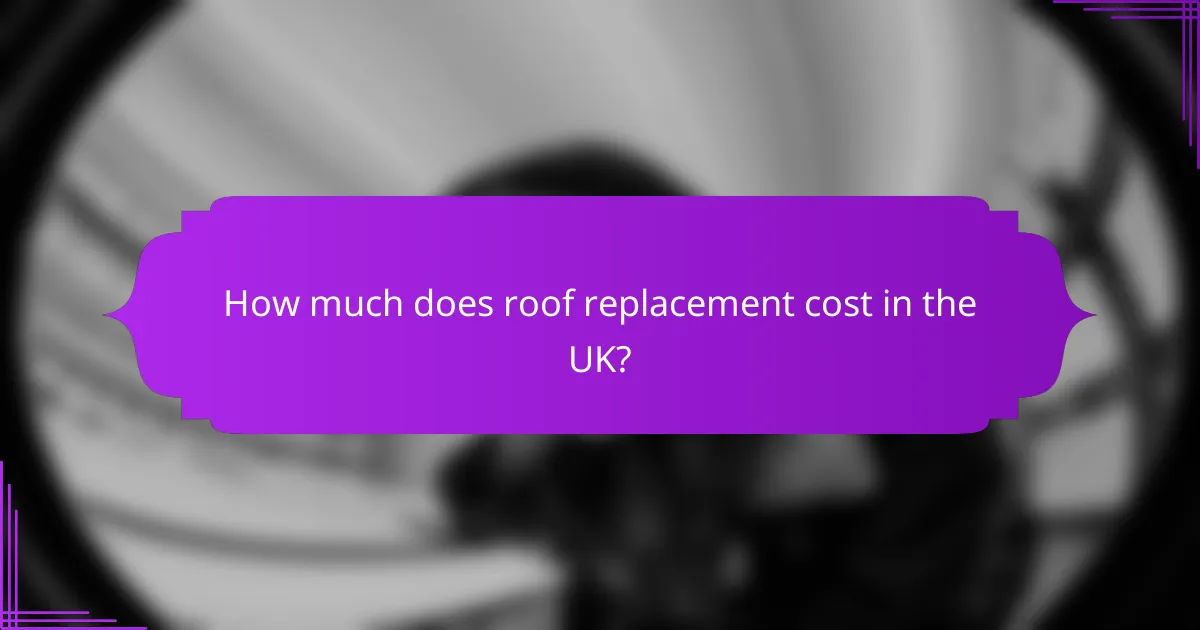
How much does roof replacement cost in the UK?
The cost of roof replacement in the UK typically ranges from £4,000 to £10,000, depending on various factors such as the type of roofing material and the size of the property. Homeowners should budget for both materials and labor when planning for a roof replacement project.
Average cost range for residential roofs
The average cost for replacing a residential roof in the UK generally falls between £4,000 and £10,000. For smaller homes, costs may start around £4,000, while larger properties or those requiring premium materials can exceed £10,000. On average, homeowners can expect to pay around £5,500 to £7,500 for a standard roof replacement.
Different roofing materials will also impact the overall cost. For instance, asphalt shingles are often the most affordable option, while slate and tile roofs can significantly increase expenses.
Factors influencing roof replacement pricing
Several factors can affect the pricing of roof replacement in the UK. The type of roofing material chosen is a primary consideration, as some materials are more expensive than others. Additionally, the size and pitch of the roof can influence labor costs, with steeper roofs typically requiring more work and safety measures.
Other factors include the condition of the existing roof, any necessary structural repairs, and the location of the property. Urban areas may have higher labor costs compared to rural regions. It’s advisable to obtain multiple quotes from contractors to ensure a competitive price.
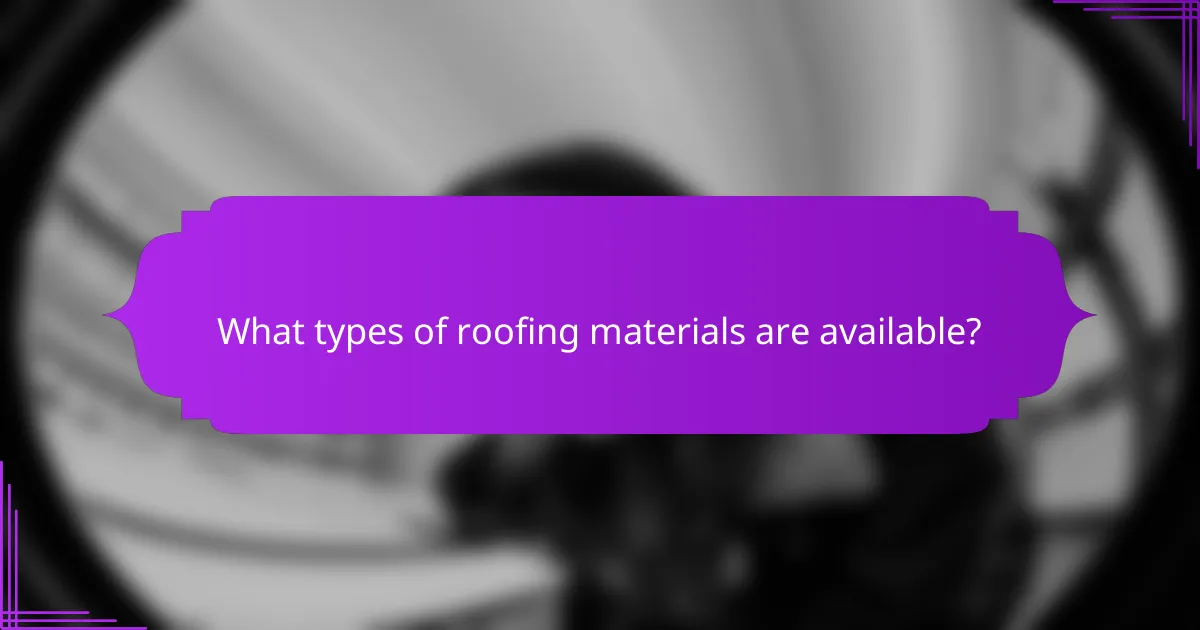
What types of roofing materials are available?
There are several roofing materials available, each offering unique benefits in terms of durability, weather resistance, and aesthetic appeal. The most common types include asphalt shingles, slate tiles, and metal roofing, each suited for different budgets and preferences.
Asphalt shingles for affordability
Asphalt shingles are one of the most popular roofing materials due to their cost-effectiveness. They typically range from $90 to $100 per square (100 square feet), making them accessible for many homeowners.
These shingles come in various colors and styles, allowing for customization to enhance the home’s appearance. However, they generally have a lifespan of around 15 to 30 years, which is shorter compared to other materials.
Slate tiles for longevity
Slate tiles are renowned for their exceptional longevity, often lasting over 50 years with proper maintenance. While the initial investment can be high, typically ranging from $600 to $1,500 per square, their durability can make them a cost-effective choice in the long run.
These tiles are also highly resistant to weather elements, making them ideal for regions with severe conditions. Their natural beauty adds significant aesthetic value, but installation requires skilled labor, which can increase overall costs.
Metal roofing for durability
Metal roofing is celebrated for its durability and resistance to extreme weather, often lasting 40 to 70 years. Prices usually range from $300 to $700 per square, depending on the type of metal used.
This material is lightweight and can reflect solar heat, potentially reducing energy costs. However, it can be noisier during rain or hail, and proper insulation is essential to mitigate sound issues.
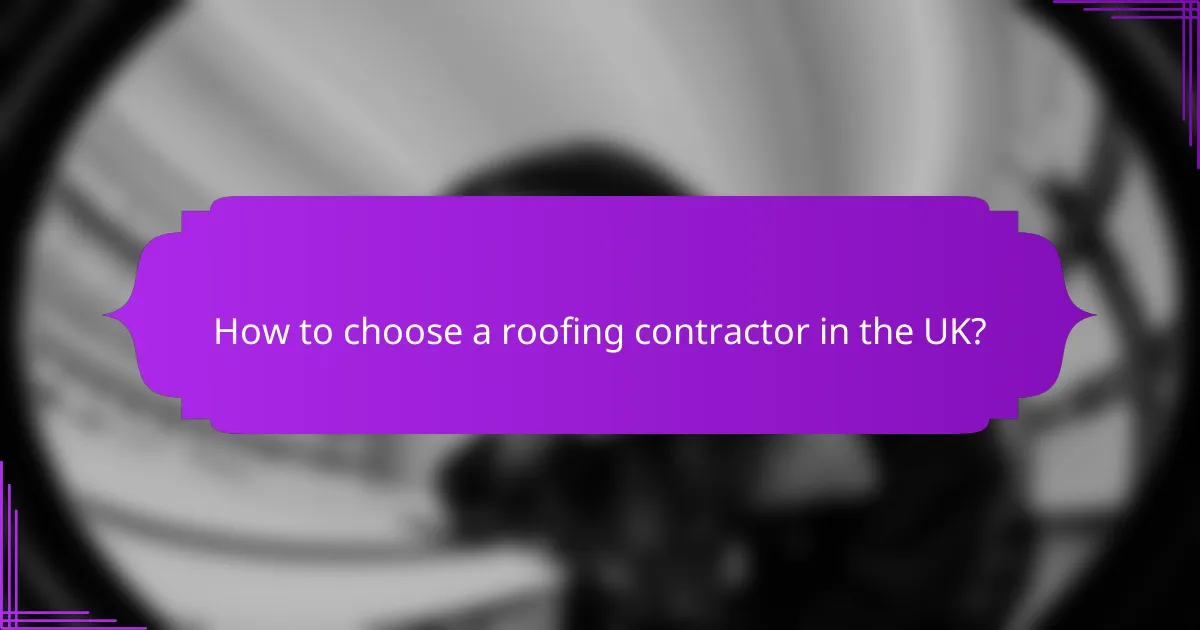
How to choose a roofing contractor in the UK?
Choosing a roofing contractor in the UK involves verifying their qualifications, assessing their reputation, and ensuring they meet local regulations. This process helps ensure you receive quality workmanship and reliable service.
Check qualifications and certifications
Start by confirming that the contractor holds relevant qualifications and certifications. Look for memberships in recognized organizations such as the National Federation of Roofing Contractors (NFRC) or the Confederation of Roofing Contractors (CORC).
Additionally, ensure they comply with local building regulations and health and safety standards. This can include having proper insurance coverage, which protects you in case of accidents or damage during the project.
Read customer reviews and testimonials
Customer reviews and testimonials provide insight into a contractor’s reliability and quality of work. Check online platforms such as Trustpilot, Google Reviews, or local forums to gauge previous clients’ experiences.
Look for consistent positive feedback regarding their professionalism, timeliness, and communication. Be cautious of contractors with numerous negative reviews or unresolved complaints, as these can indicate potential issues in their service delivery.
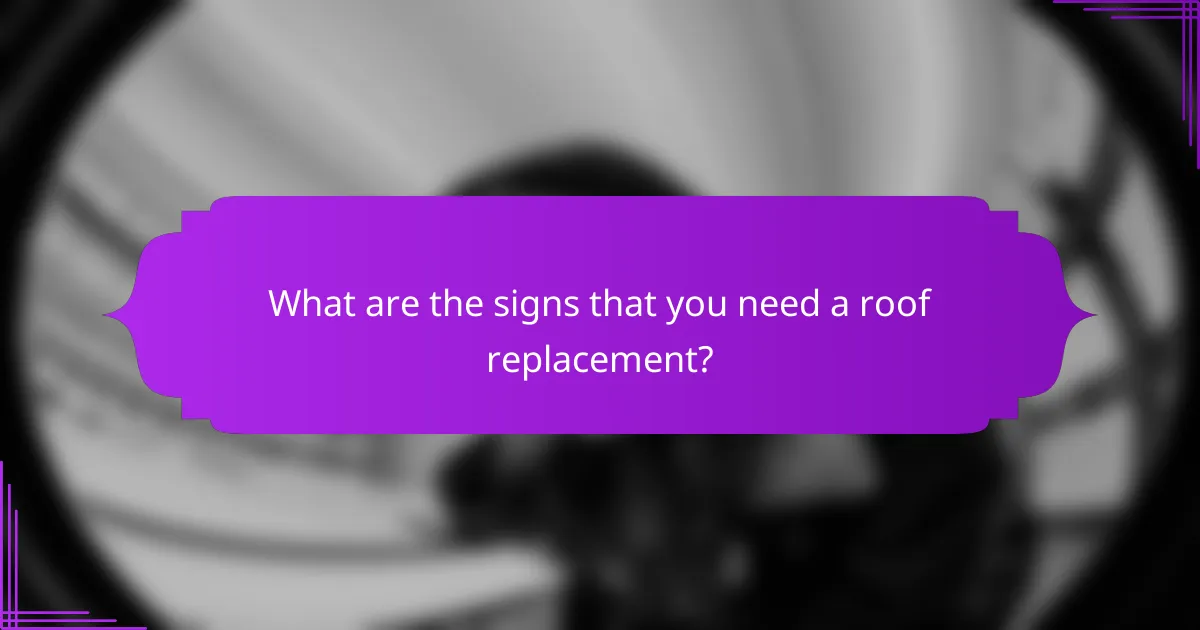
What are the signs that you need a roof replacement?
Signs that indicate a need for roof replacement include visible leaks, water damage, missing or damaged shingles, and the roof’s age exceeding 20 years. Recognizing these signs early can help prevent more extensive damage and costly repairs.
Visible leaks and water damage
Visible leaks and water damage are clear indicators that your roof may need replacement. Look for water stains on ceilings or walls, which can signal that water is penetrating the roof structure. If you notice leaks during heavy rain or after snow melts, it’s crucial to address these issues promptly.
Inspect your attic for signs of moisture or mold, as these can also indicate roof failure. If leaks persist despite repairs, it may be time to consider a full roof replacement to ensure long-term protection for your home.
Missing or damaged shingles
Missing or damaged shingles can compromise your roof’s integrity and lead to further issues. Check your roof for any shingles that are cracked, curled, or completely missing. These conditions can expose the underlying materials to the elements, increasing the risk of leaks.
If you notice a significant number of damaged shingles, it may be more cost-effective to replace the entire roof rather than patching individual areas. Regular inspections can help you catch these problems early and maintain the roof’s durability.
Age of the roof exceeding 20 years
If your roof is over 20 years old, it is likely nearing the end of its lifespan, depending on the materials used. Asphalt shingles typically last around 20 to 30 years, while metal roofs can last significantly longer. Knowing the age of your roof can help you plan for a replacement before major issues arise.
Even if there are no visible signs of damage, older roofs may not perform well against extreme weather conditions. Consider having a professional inspection if your roof is approaching or has exceeded this age to evaluate its condition and discuss replacement options.
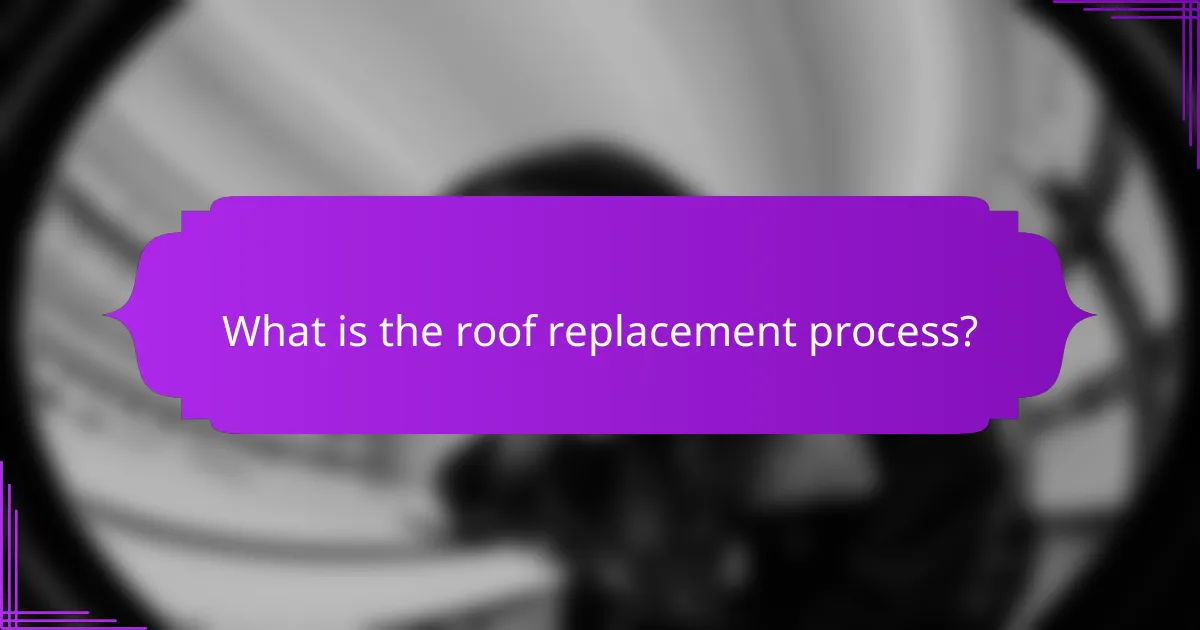
What is the roof replacement process?
The roof replacement process involves several key steps to ensure a durable, weather-resistant, and aesthetically appealing new roof. It typically includes an initial inspection, material selection, and the actual installation, each requiring careful consideration to achieve the best results.
Initial inspection and assessment
The first step in the roof replacement process is conducting a thorough inspection and assessment of the existing roof. This involves checking for damage, leaks, and the overall condition of the roofing structure. A professional roofing contractor will evaluate whether a complete replacement is necessary or if repairs could suffice.
During the assessment, factors such as the age of the roof, local weather conditions, and building codes will be considered. Homeowners should expect to receive a detailed report outlining the findings, which will guide the next steps in the replacement process.
Material selection and procurement
Choosing the right materials is crucial for ensuring the new roof’s durability and aesthetic appeal. Common roofing materials include asphalt shingles, metal, tile, and slate, each offering different benefits in terms of longevity, cost, and style. For instance, asphalt shingles are often favored for their affordability, while metal roofs are known for their longevity and energy efficiency.
Once materials are selected, homeowners should procure them through reputable suppliers, ensuring they meet local building codes and standards. It’s advisable to compare prices and warranties from different suppliers to secure the best deal. Additionally, consider the installation costs associated with each material type, as these can vary significantly.
